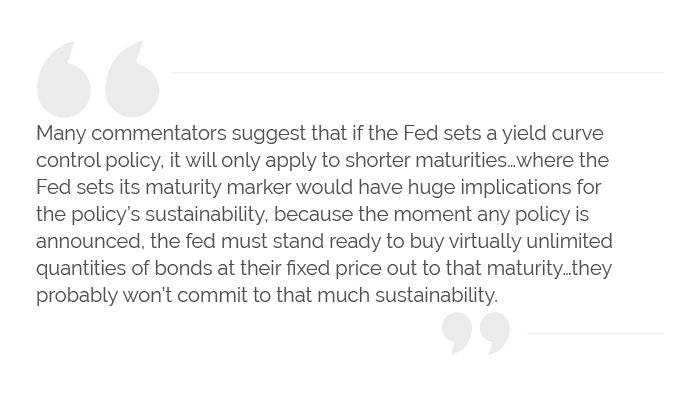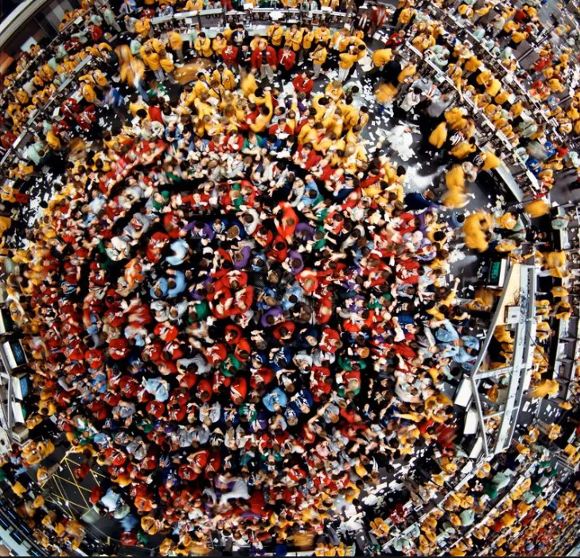I have been getting a lot of questions around rumors of
potential yield curve control—that is, the Fed attempting to fix treasury yield
curve rates indefinitely out to some maturity. How would that work? What would
the implications be? Would it even be sustainable? I figured since that this
has never happened before, I needed to do some research. The first thing I
learned is that I was wrong—it has
happened before, but long before anyone reading this blog was likely to have
been engaged in the markets.
During World War II, the Fed set a yield curve control
policy:
"By
mid-1942 the Treasury yield curve was fixed for the duration of the war,
anchored at the front end with a ⅜ percent bill rate and at the long end
with a 2½ percent long-bond rate. Intermediate yields included
⅞ percent on 1-year issues, 2 percent on 10-year issues, and
2¼ percent on 16-year issues." [source: Federal Reserve Bank of New
York]
A "guaranteed" positively-sloped curve was a boon for savvy
investors. If you knew for a fact that the price of your bonds could not go
below the federally mandated rate, your investment decision became fairly
straightforward: simply buy the longer-dated maturities with no price risk and
as they got shorter, sell into a "guaranteed" lower yield (higher price) bid.
Of course, long-term, this makes for an untenable market—because
it is not a market. Surprisingly, however, this wartime policy remained in
place until at least 1950. Maybe not so surprising, politically. Imagine how
difficult it must be when it comes time to unwind such a policy. This is
regularly the case when you try to reintroduce market forces into a non-market
driven price structure.
Savvy (and probably in many cases, politically influential)
investors piled into an interest rate risk-free investment—and you want to
spring risk on them right in the middle of it? Do you let that happen
overnight? Do you manage towards some estimate of where the market wants to be?
Who determines that and which constituency loses by that determination? Yikes!
I haven't run across the bloody historical details, but I can observe that the
war ended in 1945 and it took them at least until 1950 to unwind the mess.
And yet, the Fed is considering taking this approach again. If
they do, what will happen? What was probably ugly in 1942 is unlikely to be
prettier today. To be clear, I have no expertise in Fed policy, but I'd like to
share some thoughts about what they might be considering, and then share a
historical event that I did witness which suggests that whatever the plan, it
could fall apart.
First, I believe that the market is giving probability-weighted
credence to some kind of yield curve control policy coming into effect. Such a
policy has been in place for quite some time in Japan, and one was recently
adopted by the Reserve Bank of Australia.

Many commentators suggest that if the Fed sets a yield curve
control policy, it will only apply to shorter maturities. What does that mean?
Out to three years? To five? Where the Fed sets its maturity marker would have
huge implications for the policy's sustainability, because the moment any
policy is announced, the Fed must stand ready to buy virtually unlimited
quantities of bonds at their fixed price out to that maturity. If they set
their maturity mark at five years, to be 100% sustainable, the Fed must be
willing and able to purchase every single outstanding treasury obligation five
years or shorter, in the world. They probably won't commit to that much sustainability.
So when a player in a game like this does not have truly
unlimited resources, what can happen?
I've seen this kind of thing go bad, first hand.
In 1992, I was trading in the British Pound futures pit at
the Chicago Mercantile Exchange. Yep, open outcry—think of the last act of
"Trading Places." At the time, the British Pound was semi-officially tied to
the German Mark due to the new treaties within the burgeoning Eurozone. The
hoped-for rate was roughly 2.7 German Marks per British Pound. The Bank of
England would intervene to support this semi-fix by buying all the pounds at
this price "it needed to." Market participants, including those of us in the
pit, knew that this was an artificially high price for the pound, but we also
realized that it is hard to overcome a government mandate, since they have "virtually"
unlimited funds.
George Soros changed that. Mr. Soros had a very large fund of his own, and every other day or so he would send into our pit his two traders. They both wore bright purple jackets, one was an extremely tall and large man, and one was very short. We could always see them coming, and when they did, they sold the pound. They always sold, and they sold in massive quantities…"virtually" unlimited quantities. It was hard for us to even conceive of the size of their total position. Week after week they would sell. Ultimately, they broke the Bank of England, and in its capitulation, the price of pound futures cratered. Britain had to remove itself from the ERM. The Purple Pair returned to the pit and bought the pound like crazy. And George Soros made a staggering fortune.

This is the problem with financial price controls, whether
exchange rates or, in my opinion, the yield curve. It will work until it
doesn't, and if it suddenly doesn't—Katie bar the door!
Are there other tools available to the Fed? Well, there is
the negative interest rate policy NIRP. Most banking professionals don't like
that option, either. The Fed probably doesn't like some of its implications,
either, such as effectively penalizing banks for holding excess reserves. A
negative fed funds rate would also have major implications for the value of the
dollar and probably many unknowable effects on the general economy.
So, they are stuck between a rock and a hard place. It seems
that a negative fed funds rate would be easier to unwind than a yield curve mandate, but both strategies have
significant and unknown risks.
We are no longer in 1942. Think about it—in 1942, dealers
used to consult thick books with chapters, pages, and columns organized by maturity
dates, coupons, and yields to determine bond dollar prices. There were no hand-held calculators, not to
mention computers and high-speed internet. Since then, the number, size, and
scope of capital markets have grown exponentially. Would the Fed also attempt
to control the prices of mortgage-backed securities, derivatives, asset-backed
securities, and municipal bonds? Just controlling Treasury prices would be
tough enough, but I think it is probably logistically impossible to control all
of today's market forces. The market will find a way to appropriately price
risk and interest rate exposure by either participating at certain levels or
exiting the given market. A clearing price will be found. Just as Soros'
certitude and bankroll allowed him to break controls on the pound, eventually, the market will set its prices.
So, does that mean that the Fed can do nothing? No. I think they will debate the merits and choose one of the two bad options in front of them. I just don't know which one they will choose. To ignore either possibility would be silly and short-sighted. These are the only real tools left for the Fed. So, if I were running a fixed income portfolio, I would be debating the situation in the following ways:
- What if rates do go negative across some or all of the curve? How would we react? What immediate steps should we take? What would we do with our borrowings, and if I were a depository institution, what would I do with my deposit rates? What would it cost me to take hedging actions now, and what actions would those be?
- If yield curve controls are instituted, what would that mean to my bond and loan portfolios? That's a tough question that should be discussed in very serious terms, especially if like most, my major exposure is not in Treasury securities, but in instruments that have generally priced off of treasuries?
As I said in my previous post, we may have entered the
summer doldrums, but we should use this as an opportunity to prepare for potentials
storms to come. The time to calculate a safe course through hazardous shoals is
not when the wind and sea are already hitting you in the face—it's while things
are still relatively calm.
And remember: Keep your eyes alert for the arrival of any men
in purple coats.
Final, final thought: I have discovered raspberry lemonade—you
should too.


